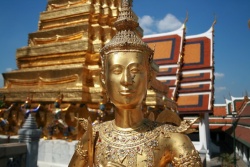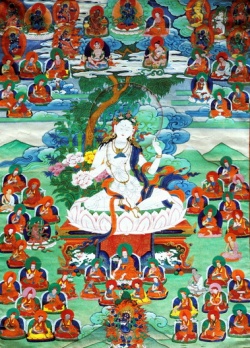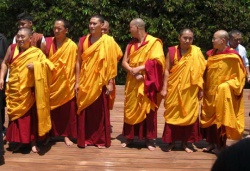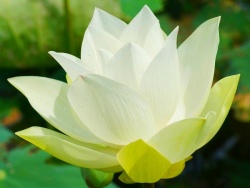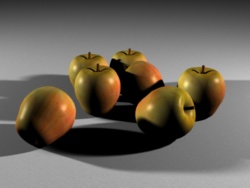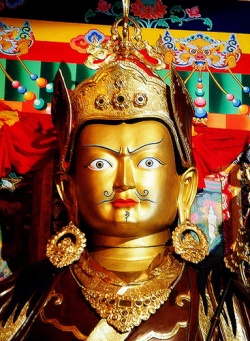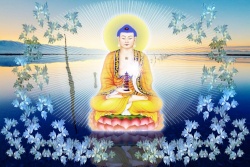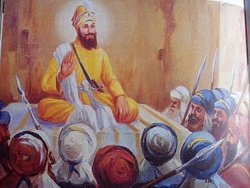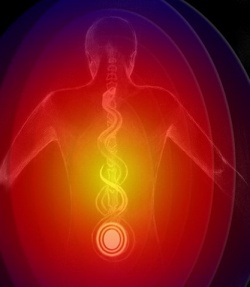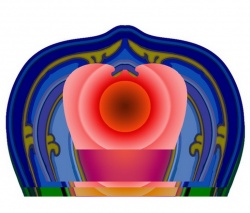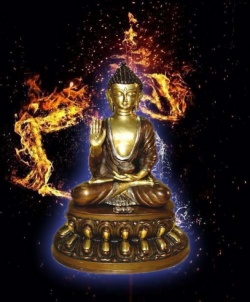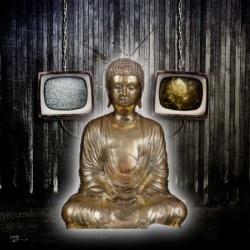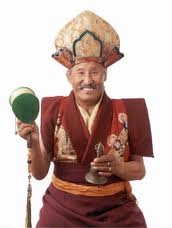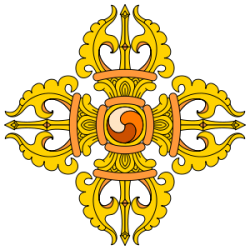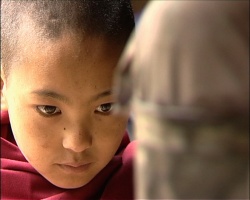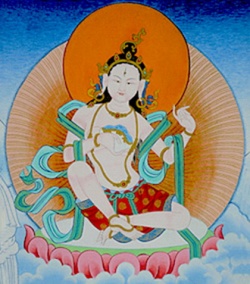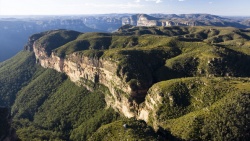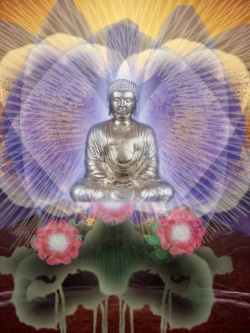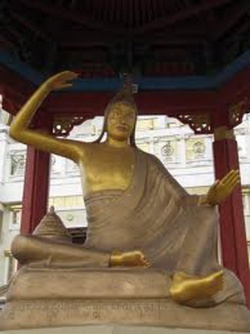Locana – water and mirror-like wisdom
Making Connections
A sense of connectedness, of relationship, is one aspect of what develops as we follow the spiritual path. When we are at our most alive, we feel in relation to both our inner world and the outer world. When we are in a creative mood we start to make new connections between things. On the other hand, we only have to look at our language to see that feeling ‘disconnected’, ‘cut off’ or ‘isolated’ is a painful and deadened way to experience. Tantric Buddhism is both highly creative and concerned with the true nature of things in which everything is interconnected. So it is not surprising that over the centuries the Tantra has woven a fine tapestry of associations around the Jinas and the Prajñas. In order to make the most of both the visualizations and the pujas, we need to be aware of these connections and correlations. By doing this we shall enrich our practice, because calling to mind the Prajñas will be linked in our minds to many different experiences and feeling-tones. Also we shall enrich our life, because many things that we see will remind us of the Prajñas, and therefore of the wisdom and compassion that they represent.
In Meeting the Buddhas I gave a table of correlations for the Five Jinas. As we’ve seen, many of those associations are equally valid for the Prajñas. I’ll give a similar table here for the Prajñas, focusing on those associations that will be particularly helpful if you are working with the pujas or sadhanas.
The Jinas are particularly associated with the skandhas, a traditional analysis which was used to show that what we think of as ‘me’ is actually a collection of different processes. As we saw in the previous chapter, the Prajñas are strongly linked both with the elements and the Five Wisdoms (Jñana in Sanskrit). Thus they are connected both to the natural world, through the elements that make it up, and to ways of experiencing that are transcendental – the Wisdoms. This way in which they span both everyday and spiritual reality is one of the most appealing facets of the Prajñas. The fact that they do so also suggests that these two aspects of reality are linked on a deep level. We shall look at the different correlations as we explore each figure in turn.
Table 1: Correlations with the Five Prajñas
Correlations Locana Mamaki Pandaravasini Tara Akasadhatesvari
COLOUR Blue Yellow Red Green White
ELEMENT Water Earth Fire Air Space
WISDOM Mirror-like Sameness Discriminating All-Accomplishing Dharmadhatu
JINA
CONSORT
Aksobhya Ratnasambhava Amitabha Amoghasiddhi Vairocana FAMILY Vajra -
Thunderbolt Ratna – Jewel Padma – Lotus Karma - Action Buddha – Awakened
DIRECTION IN MANDALA East South West North Centre
TIME OF DAY Dawn Noon Sunset Midnight
EMBLEM Vajra Jewel Lotus Crossed Vajra Wheel of the Dharma
MUDRA Touching the Earth Supreme Giving Devotion * Ringing the Vajra Bell *
Turning the Wheel of the Dharma
SEEDSYLLABLE
LOM MAM PAM TAM AM ANIMAL Polar Bear* Camel * Phoenix * Cobra * Lioness * POISON Hatred Pride Craving Envy and Fear Ignorance
REALM Hells Human Hungry Ghosts (pretas)
Animals* and titans (asuras) Gods (devas and Brahmas)
MAGICAL FUNCTION
Destroying Increasing Attracting All Functions Pacifying
AGGREGATE (Skt: skandha) Form** (rupa) Feeling** (vedana) Discrimination** (samjña) Volitions**(samskara)
Consciousness** (vijñana)
- denotes associations that are non-traditional.
- The aggregates are particularly associated with the Five Jinas, but it is helpful to bear them in mind when thinking about the Prajñas. 16
Rather than give my interpretation of the meaning of ‘Locana’, I shall borrow one from the Register of the Western Buddhist Order. We now have a Dharmacharini called Locana, who also happens to be a Sanskrit scholar. So her very reliable entry under ‘meaning of name’ in the Register reads: She who is illuminated by the Dharma. Also means 'eye' as in the 'eye of wisdom'. So we can gather that Locana, the Prajña, is a figure who embodies clear seeing.
This is brought out in her association with the ‘mirror-like wisdom’. As its name suggests, this wisdom is objective – a state in which your mind reflects experience impartially and objectively. It is a calm state, just as water has to be calm in order to function as a mirror. This wisdom is the fullness of equanimity, in which life is allowed to flow along as it is, with no ‘for’ and ‘against’. For this to come about, one has to have ceased, at least temporarily, producing the idea of an ego, with its cravings and aversions, its likes and dislikes. In this state you just let experience be.
Sometimes people imagine that this wisdom must be cold – impersonal and unfeeling. They imagine it as being a bit like some piece of machinery that registers impartially – a speed camera perhaps. But this is completely wrong. It is how you experience when you are not building an ego-barrier between yourself and life. So it is a very alive, organic state.
Mirror-like wisdom also has a further connotation for me. A mirror presents a whole world to us, but that world is not in the direction in which it appears to be. Similarly, we tend to interpret life in terms of looking out from within at a world that is external to us. While some Buddhist schools are happy to see things in this way (provided that nothing is seen as fixed), others challenge the whole idea of a subject/object dichotomy.
For the Yogachara School, there is no need to introduce the concept of matter as opposed to mind. Everything is mind. They argue that while we may interpret ourselves as perceiving an ‘outside world’, all that we ever have is our own experience. So when we see an outer reality, all the time we are actually experiencing our own mind. For the Yogachara the situation in waking life is not fundamentally different from that in dreams, where we appear to be experiencing something outside ourselves, but are actually still dealing with our own mental contents. Just as the mirror may appear to contain an environment, people and so on, similarly we think we perceive an ‘outer world’ when actually the truth lies in another direction, within the mind.
Just as the contents of a mirror are ungraspable, in the same way the contents of experience cannot finally be got hold of. They are essenceless and constantly changing. And just as a mirror is never affected by what passes across it, so at a deep level the mind is unaffected by whatever it experiences. We can gain some feeling for this mirror-like wisdom by noticing how our mind always perfectly reflects what is happening.
This doesn’t mean that our senses, including the mental sense, are up to the job of giving us a total picture of the universe. It means that however the senses are functioning the mind always accurately reflects that state. So if I stand on a hilltop on a sunny day with my eyes open, my mind accurately represents what is happening - the scene below and the effect of the 17 sunlight on my retina. Similarly, when I was 18 and got very drunk at a college debate, my mind perfectly recorded the crazy way that the pillars in the old cloistered building spun before my eyes as I tried to stagger back to my room. So as the embodiment of the mirror-like wisdom and water, Locana is clear-seeing, calm, and equanimous.
Elements of the visualization
In dealing with each of the Prajñas we shall look first at the details of her figure, and then go verse by verse through the puja, picking out points that need explaining or amplifying. In discussing the figures I do not propose to give a detailed commentary on the whole sadhana. Most readers of this book will be working with the pujas rather than performing the entire visualization practices. But in order to gain the most benefit from the puja you need to have called to mind the figure of the Prajña and her qualities. After all, a puja is a devotional ceremony directed to a spiritually developed figure. In order to feel devotion you need to be in touch emotionally with that figure.
I have sometimes sat in pujas - both within and outside the FWBO - where no time or thought was given to calling to mind the Buddhas and Bodhisattvas before we started. In consequence people recited the puja ‘into the empty air’, in a flat or distracted way, disconnected from any emotion. So I shall go through the part of the visualization in which the Prajña’s appearance is described, so that when doing her puja you can call her to mind and bear in mind something of the symbolism of her figure. Order members who are performing a sadhana of one of the Prajñas and have questions about it are welcome to contact me.
The Water Mandala
In the sadhana Locana is visualized as appearing above a water mandala - a circle of pure, clear water. This water mandala is the essence of the water element. As it is calm, it forms a perfect mirror, like the still surface of a lake. For me the water mandala has a visionary quality. There are certain lakes and pools in which someone with psychic gifts may learn all manner of things. For instance, in Tibet, the lake Lhamo’i Lhatso was used to look for indications of where important lamas would be reborn.
I like to visualize the water mandala and then look into it in order to see things clearly. As Locana’s wisdom is the antidote to hatred, it is a very good practice to visualize the water mandala and then to see within it the image of someone whom you dislike or have trouble with. The calm water and the reflection give you a distance and perspective, enabling you to see them as they are in themselves, aside from the role that they are playing in making you angry or upset. It can also be helpful to see yourself and your actions reflected in the water mandala, as a way of seeing impartially who you are and how you live.
There are two options for what happens next in the sadhana once you have visualized the water mandala. You can move straight on to the lotus. But if you like you can imagine the supporting throne with its animals. If you practise in this more elaborate way, then out of the water mandala arises a throne made of pearl. The sadhanas incorporate ten precious stones: in the thrones and in the jewels worn by the Prajñas. These ten are the substances that Sangharakshita describes in The Ten Pillars of Buddhism.
In that published paper, he discusses the ten precepts taken by all members 18 of the Western Buddhist Order, and associates each one with a precious stone or material. I find these correlations very helpful to reflect on, as they help to prevent the precepts from becoming a list of rules by emphasising the beauty and preciousness of the mental states that they promote.
It seemed appropriate for Locana to have a pearl throne. Firstly, of course, pearls are found deep in the water, which is Locana’s element. Secondly, Sangharakshita associated the Fourth Precept, about truthful speech, with pearl. He said that in order to speak the truth, even in a factual sense, you have to dive very deep within yourself, just as a pearl diver needs a long breath to find a pearl on the ocean bed.
The Polar Bears
If you are including the throne, then it is supported by polar bears. You can see them appear above the water mandala, but I prefer to see them rising up out of it. First they break its calm surface, then they take their places with their paws appearing to stand on the paws of their reflections in the mirror of the mandala. Of course these animals are completely non-traditional – India being a bit of a hot habitat for polar bears. All these animals came intuitively, but I can see why the polar bears might have turned up with Locana. Polar bears are very at home in the water, though they also spend time on land. (Several of the Prajñas’ animals have turned out to have connections with two elements, for some reason.)
They are also dangerous, sometimes vicious beasts who live by killing other creatures. Their staple diet is seals, but they also kill and eat reindeer, small rodents, seabirds, ducks and fish. This makes them a good symbol for the cold hatred that is the poison that Locana overcomes. Symbolically the polar bears supporting her throne suggest that the energy of hatred has been transformed and now is in the service of the Awakened state.
Although polar bears are aggressive animals, the beautiful creamy white of their coats also suggests purity. In Buddhist Tantric texts, such as the Bardo Thodol, popularly known as the Tibetan Book of the Dead, Aksobhya who is Locana’s consort is sometimes linked with Vajrasattva, the Buddha who embodies the purity of the Enlightened state. So the polar bears also hint at that link with Vajrasattva. From the centre of the water mandala grows a pale-blue lotus flower,..
Next appears the lotus throne. If you have left out the throne and the bears then it appears on top of the water mandala. Again, as lotuses rise through water to blossom on the surface, you see the lotus appearing out of the water. If you already have the pearl throne in place then the lotus simply appears on top of it. The lotus is made of pale-blue light. Lotuses have many associations, and are given different symbolic meanings in Buddhist Tantra. One obvious one is that they are symbols of renunciation of unskilful states of mind – just as the lotus leaves its muddy bed and rises into the sunlight.... on which rests a moon mat.
On the lotus throne appears a moon mat. This is a perfect circle of white light, like a full moon, that forms the seat of the Prajña. It suggests that all her good qualities are complete and perfect, just as the full moon has reached its maximum radiance.
In some systems of correspondence the moon mat is associated with the Relative Bodhicitta, i.e. with compassion for all that lives. On the moon mat appears the female Buddha, Locana. The great Tibetan teacher Je Tsongkhapa wrote a famous text on the Three Principal Paths of Buddhism.
First you develop renunciation - you give up on the repetitive, habitual cycle of mundane life (Skt: samsara), seeing that it will only give you frustration; second you develop love and compassion so that you are motivated to gain Enlightenment for the sake of all living beings; thirdly you develop wisdom, the clear seeing that enables you to be of true help to the world. That scheme can be seen as represented symbolically here by the lotus, the moon mat and the figure of Locana, who embodies enlightened wisdom.
For some schools of Buddhism the idea of a female Buddha would be a contradiction in terms. So you find some Mahayana sutras in which women close to Enlightenment become transformed into men so that they can take the final steps to Buddhahood.
But Buddhist Tantra gives a high value to women, and sets no limits on what they can achieve. On the level of the Awakened Mind, distinctions of gender disappear. But here we are concerned with symbolism, in which a female form can suggest slightly different aspects of the Enlightenment experience from a male one.
She is blue in colour, seated in the vajra posture. Her body is made of blue light, suggesting the ungraspable nature of experience. I deliberately did not specify what shade of blue she should be. Often the Prajñas are represented as somewhat paler in colour than the Jinas. This may just be for practical purposes, so that the two figures are more clearly distinguishable when they are represented together in Yab-Yum. So it is up to you to see what your Locana looks like as she appears in your imagination.
The vajra posture is the cross-legged posture in which each foot is on the opposite thigh. In the West it has become more commonly known as the Lotus Posture because of its use in Hatha Yoga. Buddhist figures in paintings and sculptures tend to have the right leg on top; Hindu figures are often the reverse. This vajra posture is very solid and stable. It is appropriate for the consort of Aksobhya, whose name means ‘the imperturbable’. It is only Transcendental Wisdom that gives you an unshakeable place to stand in the flood of mundane existence. So Locana’s vajra posture emphasises her wisdom.
She is dressed in exquisite clothing, and is adorned with diamonds and other precious things.
Again, I have not been very specific about how the Prajñas are dressed, in order to allow each person to visualize whatever they find beautiful and engaging. Sangharakshita is of the opinion that we should not continue in the West the way in which female Bodhisattvas are often represented as scantily clad in the Indo-Tibetan tradition. He would prefer these figures to be represented in beautiful dresses or similar clothing. The colours that Locana wears are also up to you. I tend to visualize her wearing a short-sleeved blue upper garment and a silver skirt, but these aesthetic issues are very personal, and my choice might not suit you at all. The most important thing is that you should enjoy visualizing the figure so that your concentration will flow more easily.
In The Ten Pillars of Buddhism Sangharakshita connects diamond with the first of the Ten Precepts – not killing or, more positively, love. He says that diamond is the hardest natural substance and thus appropriate for love because the ‘love mode’ is ‘harder’ and more enduring than the ‘power mode’. Her right hand is in the earth-touching mudra holding a golden vajra.
This gesture of touching the earth (Skt: bhumisparsha) is made by placing the hand on the right knee with the palm turned inwards, so that the tips of the fingers just reach the ground. Locana’s gesture is identical to that of her consort Aksobhya. It is associated with the incident where the Buddha Shakyamuni was challenged by Mara (the embodiment in Buddhism of everything that holds us back spiritually) when he was on the verge of gaining Enlightenment, and responded by touching the earth. Out of the ground emerged the Earth Goddess who testified that the Buddha was ready to gain Enlightenment because she had witnessed his practice of skilful actions over many lifetimes. To me this gesture has connotations of touching the bedrock of experience.
The power of the gesture is reinforced because Locana holds in her hand the supremely powerful vajra-sceptre, the tantric symbol that unites all the qualities of the diamond and the thunderbolt. The vajra gives its name to the family (Skt: kula) of figures that is headed by Locana and Aksobhya. Here the vajra is held horizontal, so that it is largely hidden by Locana’s four fingers in the earth-touching mudra. This suggests that Locana wields great spiritual power that it is not openly displayed, but is more hidden and inner.
Her left hand is at her heart. On its open palm stands a vajra-bell. As we shall see, all the Prajñas are visualized with a vajra-bell. This is not surprising, as they particularly embody the wisdom aspect of Enlightenment. In Buddhist Tantra the two principal symbols are the vajra and bell. When they are seen together, the vajra stands for compassionate skilful action and the bell symbolises wisdom. The bell is a very rich and complex symbol, including a whole mandala. (See my book The Vajra and Bell.) Below the vajra-handle on the bell is the face of Prajñaparamita, the goddess of Perfect Wisdom. When we see the vajra-bell on Locana’s palm this face is turned outwards, towards us.
I cannot think of a traditional Buddhist figure that is represented holding the bell to their heart in this way. This mudra arose spontaneously, but I can see that it parallels – or in Locana’s case ‘mirrors’ might be a better word – the way in which Vajrasattva holds the vajra to his heart with his right palm. (We have already seen that there is a link between Vajrasattva and Aksobhya and Locana.) I find this gesture very rich. The bell is a symbol of wisdom and of feminine qualities. Locana holds it to her heart, valuing it. There are times when for me she seems to be looking down at the bell and contemplating it. At others she is holding it up, offering wisdom from her heart as a gift to all beings.
On her head is a five-jeweled crown.
All the Prajñas wear this, as do the Jinas. The five wisdom jewels are the colours of the Five Prajñas. This suggests that the Prajñas are not, finally, five separate figures. 21 They are simply Enlightenment presenting itself in five different guises. It also conveys the idea that the Five Wisdoms are not fully separable, and that all the Prajñas embody them all; they each just emphasise a particular one. She has long black hair, some of which is bound up in a topknot, the rest flowing over her shoulders.
This is the way in which Tara and other female Bodhisattvas are represented. It is different from the abandoned loose hair of the dakinis. As virtually everything in these visualizations has symbolic meaning, we could interpret this partly bound-up hair as suggesting a balance between form and formlessness, discipline and spontaneity.
In front of her topknot sits the deep-blue Buddha Aksobhya. I did consider leaving the Jinas out of these sadhanas altogether, as the Prajñas are quite self-sufficient. But eventually I decided to include them for a few reasons. I felt that most people approaching the Prajñas and their symbolism would do so via knowing about the Jinas, so I thought it would be good to include the Jinas to help people integrate their feelings for them into visualizations of the Prajñas.
Also, the Jinas and Prajñas are very closely linked – in a sense they are one figure – so it felt very natural to have the Jinas there. And they add another dimension of richness to the visualization - a further figure with its own potent spiritual symbolism. My only doubt about including the male figures was that people might take it that the Prajñas are somehow less Awakened, and therefore need the Jinas on their crowns as gurus to teach them. That certainly isn’t my reading of the situation, and I thought it was worth taking the risk of misunderstanding in order to gain the benefits mentioned above.
He is in the vajra posture, with his right hand in the earth-touching mudra, and his left resting in his lap, supporting an upright golden vajra. This is a common way in which Aksobhya is visualized. Locana's head and body are surrounded by auras of light. These head and body auras are traditionally associated with what are known as the Two Accumulations (Skt: sambhara). These are merits and wisdom. A Bodhisattva is said to perfect the accumulation of merits by practising the first five Perfections (Skt: Paramita): giving, ethics, patience, effort and meditation. He or she completes the accumulation of wisdom by practising the Perfection of Wisdom. The body aura of a Buddha or Bodhisattva figure symbolises the accumulated merit; the head aura represents the wisdom.
She is very beautiful, with calm blue eyes that take in everything. One or two people have questioned my stress on the beauty of the figures. They have wondered if it was sexist, reinforcing stereotypes. I don’t agree, and when we have examined the thinking behind these objections it often seems to be related to an idea that women are only seen as decorative by people who do not value their other qualities. I am not stressing the beauty of the Prajñas in order to make up for their inferior qualities in other areas! They are fully Enlightened Buddhas with all that that implies. On top of that, they’re beautiful. And anyway I often stress the beauty of male Buddhas and Bodhisattvas. These figures, made of light, loving and compassionate, with perfected qualities, can hardly fail to be beautiful. Locana’s eyes convey her mirror-like wisdom. They register everything, calmly and serenely, just as it is.
The Seed-Syllable and Mantra
In the full visualization Locana has a blue seed-syllable (Skt: bija mantra) at her heart. Her seed-syllable here is LOM, though you may find some texts in which it is given as LAM. These seed-syllables are a common feature of Tibetan Buddhist visualizations. Often figures and objects arise out of emptiness first in the form of a seed-syllable. That then transforms into the figure or object. They in their turn are often marked with the seed-syllable. Various technical meanings are ascribed to these seed-syllables.
In general we can say that they represent subtle forms, the mind working at a pre-verbal level. Sometimes if you watch your mind when you are in a meditative state you can see the beginnings of thoughts arising like bubbles. The seedsyllables are also, in a sense, the essence of a figure or object. Of course, Buddhism, denies that phenomena have any fixed essence to them, and the seed-syllables arise out of, and disappear back into, emptiness. But the seed-syllables do contain the essential qualities of a figure or object in an undiluted way. Thus in visualization practice figures and objects appear from seed-syllables in the same way that a whole string of generous actions may be generated from one particular moment in which you were seized with the urge to give.
Locana’s mantra here, which you will not find in the traditional texts, is OM VAJRALOCANE LOM SVAHA. Mantras are not usually translatable – they work at a level deeper than that of conscious meanings. ‘Vajra’ is the diamond thunderbolt. ‘Locane’ is the vocative form of Locana’s name in Sanskrit. The vocative is used for addressing or calling someone. So here it is as if we are invoking or calling upon Locana through her mantra, and we are doing so mindful of the fact that she embodies all the qualities of the vajra and the Vajra Family.
The Locana Puja
The puja to Locana was the first one that I wrote. I wanted all the pujas to have a poetic title, although I knew that they would generally be referred to as ‘the Locana puja’, ‘the Tara one’, etc. I took the titles from phrases found in the pujas themselves. The Locana puja is called Dawn of Wisdom, which comes from the Salutation section. I thought of varying the format of the pujas, but in the end I stayed with the sevenfold structure that we are very familiar with in the FWBO.
This form felt like a restriction occasionally, but overall it gave me a discipline that was helpful. I am going to give a commentary on the pujas, as many people have mentioned to me that ‘There is a lot of Dharma in them’. Some of it will be obvious, but some of it requires some explanation. I tried to write the pujas in such a way that they would be reasonably accessible on first hearing, but I wanted there to be enough in them for people to find new depths in them as they explored them more. So I didn’t shy away from including lines to do with the wisdom aspect of Buddhism. After all the Prajñas are embodiments of wisdom! To save you having to look at the puja booklets I shall quote all the puja text, so that you can see things in context, even though I shall not be commenting on all of it.
To your perfect eyes,/ That light up the world’s darkness,/ I offer endless lights./ To your perfect body,/ Exquisite but ungraspable,/ I offer endless waters and flowers./ To your perfect senses,/ Unstained by grasping,/ To which nothing is ever impure,/ I offer endless perfumes and music.
To your perfect lips,/ That never cease teaching Dharma/ But have never uttered a single word,/ I offer endless food and drink./ To your perfect mind,/ That remains in imperturbable bliss,/ Ocean deep, mirror bright,/ I offer my endless devotion./
This section is a poetic giving to Locana of what are known as the ‘offerings to the honoured guest’. In ancient India when a guest came to your house you would make them comfortable and satisfied by offering them:
1) water for drinking; 2) water to wash the feet; 3) flowers; 4) incense; 5) lights; 6) perfumed water; 7) food.
Often music is added to the set as an eighth offering. Here we make all these offerings except incense –it would have made the third verse rather cluttered to have offered perfumes, music and incense, and a verse beginning To your perfect nose… just doesn’t work! The section starts with Locana’s eyes because of her special connection with clear seeing. Her body is ungraspable, because it is made of light, of the nature of shunyata emptiness.
Salutation
Dawn of wisdom,/ Your blue radiance illuminates a new world,/ Free from suffering./ Your eyes are like calm oceans/ Reflecting perfection./ Seeing all, knowing all./ To you I joyfully prostrate./
Dawn of wisdom/ Your slender fingers/ Touch the bedrock of reality./ Your upturned palm supports the vajra-bell,/ The empty mandala of the wisdom goddess./ To you I reverently prostrate./
Dawn of wisdom,/ Destroyer of all suffering,/ In the vajra-sphere beyond subject and object/ You fashion the jagged shards of hatred/ Into wisdom’s diamond adornments./ To you I lovingly prostrate./
Dawn of wisdom,/ Vajra Queen,/ Buddha from time before time,/ Complete in yourself,/ And consort of the noble Aksobhya./ To you I endlessly prostrate./ 24 In this section we offer prostrations to Locana. If you want to you can get up at the end of each verse and make physical prostrations, or bow if they are too physically demanding for you. On a group retreat one person could make prostrations at the end of each verse on behalf of everyone.
Dawn of wisdom – of course this connects to the time of day associated with Locana and Aksobhya. It suggests that they are connected with beginners’ mind, making the effort to let go of old ideas and concepts and to see everything fresh in the moment. It also implies that mirror-like wisdom in some way is the first aspect of wisdom that we encounter. This is certainly true of ‘bare awareness’ approaches to insight. Through peeling away layers of conceptualisation we come more and more into the present moment. Finally there is a moment of simple seeing.
Our story about who we are and what life is falls away for a few instants, and we see just what is there. This moment of clear, mirror-like seeing then affects our feelings, perception, volitions and our consciousness, so that they take on the characteristics of the other four Wisdoms. The empty mandala of the wisdom goddess. A vajra-bell includes within its symbolism a whole mandala. If you see it in two dimensions, looking down on it from above as Locana is doing, you find Prajñaparamita seated in the middle, surrounded by other figures in a circular mandala, with a wall of vajras protecting the outer edge. (For more details see my book on The Vajra and Bell.) The mandala is empty both because the shape of the bell encloses empty space and because the mandala has no self-nature.
In the vajra-sphere beyond subject and object…Reality is not only empty of any inherently-existing self-nature, it is also empty of subject and object. These are just concepts that we superimpose onto how things are. When ideas of ‘me in here’ and ‘you out there’ fall away, we enter a transcendental sphere in which reality is one seamless whole. While we may partition it with our concepts, in reality it is unbreachable in the same way that a vajra cannot be cut or broken. You fashion the jagged shards of hatred/Into wisdom’s diamond adornments.
This suggests a tantric approach to dealing with negativity. In more common Buddhist practice, the kleshas or poisons are to be overcome, eradicated. In Tantra they are transformed by sublimating the energy that is tied up in them. Buddha from time before time, - Enlightenment is a timeless state. Paradoxically, when you become a Buddha you realize that you have always been Enlightened. Going For Refuge
Perfect Refuge,/ All-knowing,/ All-seeing,/ I am endlessly deceived/ By the mirage of samsara./ From now onwards/ I shall always rely on your clear vision/ To find the true path./
Perfect Refuge,/ All-knowing,/ All-seeing,/ I am full of doubts/ From Mara’s questioning./ From now onwards/ I shall always turn to you to witness/ My efforts to realize the truth./
To you, a perfect Buddha,/ Who see samsara and nirvana as they are,/ I go for Refuge./
To your mirror-like wisdom/ Unshaken in the flood of change,/ I go for Refuge./ To the entire Vajra Family,/ Born from your heart, I go for Refuge./ In this section we commit ourselves to the Buddha, Dharma and Sangha. Here the Three Jewels are embodied in Locana and the members of the Vajra Family which she and Aksobhya lead.
I am endlessly deceived/By the mirage of samsara. – Samsara is the endless round of frustrating and unfulfilling experience in which we find ourselves trapped. The mirage of course is another water image, but it also suggests that we are not really trapped at all. We are continually causing ourselves frustration and suffering by failing to recognize the true nature of our situation. Once we take a close enough look at the mechanisms of samsara we see that there is really nothing there. At that point we are free, just like the traveller who understands that the mirror is just an optical effect.
I am full of doubts/ from Mara’s questioning. This verse refers to the incident in the legendary life of Shakyamuni where, in response to Mara’s efforts to undermine his confidence, he called the Earth Goddess to bear witness to the spiritual work that he had done over many lives. He invoked the Earth Goddess by using the earth-touching mudra that we see being made by Locana.
To the entire Vajra Family, The Vajra Family includes many of the most important Tantric deities. As this family is associated with the transformation of hatred, many of its members appear in wrathful forms, including the Bodhisattva Vajrapani and the fearsome buffalo-headed Vajrabhairava.
Confession of Faults
O loving Locana,/ How can I see your beautiful face/ When my mind is like a mirror in the mud?/ It lies there,/ Sticky with grasping,/ And caked with useless fantasies./ It is cracked with hatred,/ And pitted with resentment./ It is fogged with the cold mists Of ignorance and doubt./
O loving Refuge,/ Despite its sad condition/ My mind longs to reflect your perfect eyes./ Please cleanse it with the nectar of your equanimity./ Polish it with your gentle touch./ Today I vow to begin anew./ I shall bathe in the pool of your wisdom/ And emerge with a vajra heart,/ Unshakable in your service./
For me the first verse has echoes of one of the most famous events in the history of Chinese Buddhism. Hung Yen, the Fifth Patriarch of Ch’an (the form of Buddhism that would become known as Zen in Japan), announced that he would pass on the succession in his lineage to whoever could write stanza demonstrating that they had realized the true nature of the mind. Everyone assumed that the Head Monk, Shen Hsiu, would receive the transmission of the lineage. Shen Hsiu himself was in an agony of doubt. Eventually he composed a stanza but, not being able to bring himself to give it to the Fifth Patriarch personally, he wrote it on a wall. The verse was:
Our body is the Bodhi-Tree,
And our mind a mirror bright.
Carefully we wipe them hour by hour,
And let no dust alight.
Reading this verse, the Fifth Patriarch praised its anonymous author, encouraged people to venerate the verse, and said that whoever learned it and put it into practice would avoid falling into unfavourable states of existence. Working in the monastery kitchen pounding rice, as he had been doing for many months, was Hui Neng. Although overlooked because he was poor and illiterate, he had had some taste of mind’s true nature, and when he heard the verse he wrote a verse in reply:
There is no Bodhi-Tree,
Nor stand of a mirror bright.
Since all is empty of inherent nature,
Where can the dust alight?
Although the Fifth Patriarch had praised the Head Monk’s verse, he knew that it did not demonstrate any penetration into the true nature of things. Reading Hui Neng’s verse, he saw at once that its author had experienced Awakening, so the Fifth Patriarch secretly passed on the succession to him. This Confession of Faults is clearly written from the standpoint of Shen Hsiu rather than Hui Neng.
But that is not a bad thing as after all that is where most of us are standing. And, as the Fifth Patriarch pointed out, even if we do not see the nature of the mind, if we can keep purifying our minds of faults that will save us from a great deal of suffering. It will also help to set up conditions so that one day we do see the primordially pure, unstained nature of the mind.
Queen of ever-flowing bliss,/ I rejoice in your radiant awareness,/ In your confidence and compassion,/ In your perfect knowledge/ Of dependent arising and emptiness./ I rejoice in the happiness/ Of all those you have awakened/ From the dream of samsara/ With your clear dawn light./ I rejoice in all those who,/ Despite still slumbering,/ Create delightful dreams through skilful actions./ 27
I rejoice in my own good fortune/ That like the turtle in the vast ocean/ I have somehow been encircled/ By your loving embrace./
In your perfect knowledge/ Of dependent arising and emptiness. The first verse finishes by rejoicing in another aspect of wisdom which Locana embodies. This sees things from the Madhyamika point of view expounded by Nagarjuna. For this stream of Buddhist thought, the highest wisdom is to see the perfect interplay of dependent arising (Skt: pratitya samutpada) and emptiness of inherent existence (shunyata).
In this vision of reality, everything is essenceless and non-abiding because everything that appears is a dependent phenomenon, arising when conditions are appropriate, and disappearing when those conditions change.
If phenomena had some kind of fixed inherent existence, this could not happen. So dependent arising is made possible by the fact that everything is empty of existing by itself. Emptiness is not a thing, but simply a quality of all dependently arising phenomena. The second verse – The first four lines rejoice in all those who have gained some insight into reality. The last three lines refer to those who have not yet seen the true nature of things but who enjoy positive mundane states through practising ethics and meditation.
That like the turtle in the vast ocean – This last verse refers to an image used by the Buddha in the Chiggala Sutta of the Samyutta Nikaya. He states that human life is a very precious opportunity to practise the Dharma because it is very hard to come by. He describes the situation of a blind sea-turtle who lives in the ocean and only rises to the surface once every hundred years. A small yoke is floating on the surface of the vast ocean. The Buddha asks his hearers to contemplate the odds against the turtle happening to surface at the exact spot in the ocean where the yoke is floating, so that the turtle’s head is encircled by it. He stresses that the chances of gaining human rebirth are as remote as this.
People often feel discouraged about their Dharma practice, feeling that they are not getting very far along the Path. But, if the Buddha is to be believed, we have already come a very long way. We cannot have been at all bad, as we have managed to find a human birth at a time when the Dharma is available to us. We may or may not want to take the Buddha’s image literally. But certainly if we can take the spirit of what he is saying, then we shall feel the precious opportunity that we have, and we shall work to make this life meaningful through practising the Dharma.
Entreaty and Supplication
Queen of the vajra and bell,/ If the sun of your compassion/ Never rose in the eastern sky/ All would be ice and darkness./
May you forever shine/ Your diamond light/ Upon all of us poor creatures,/ Whose hearts otherwise will freeze/ Into cold stones of hatred./ May the vajra-bell at your heart/ Burn like a beacon/ To guide us to our true home./ May you empower us to experience everything/ In its naked perfection,/ To know in the seen only the seen,/ In the heard only the heard./ O you who embody the whole of the Dharma,/ Please teach us your simplicity./
To know in the seen only the seen,/ In the heard only the heard. – This is a reference to the Buddha’s advice to Bahiya of the Bark Garment in the Udana of the Pali Canon. Bahiya has travelled a very long way to Savatthi in order to see the Buddha. On his arrival he is told by monks in the Jeta Grove that the Buddha has gone into town on his alms-round. Bahiya is so aware of impermanence and so desperate for the Dharma that he goes after the Buddha and interrupts his silent movement from house to house by begging for a teaching. When the Buddha realizes that Bahiya will not wait, he gives him a very short, direct piece of teaching: Bahiya, you should train yourself thus: 'In the seen will be merely what is seen; in the heard will be merely what is heard; in the sensed will be merely what is sensed; in the cognized will be merely what is cognized.'
In other words the Buddha teaches Bahiya mirror-like wisdom, not adding any concepts onto his experience, not working it up into a story, just experiencing it nakedly and directly.
Please teach us your simplicity. – This last line always moves me strongly. We usually miss the Dharma, the truth of things, because it is too simple for us. Even with Buddhism we can build up all kinds of grand structures of thought, when the simple truth of each moment is waiting, patiently and faithfully, for us to deign to notice it.
Diamond-adorned one,/ Only you can know/ The merits of your worship./ May they be vaster than suffering,/ Deeper than the hells./ May they overflow/ Even the ocean of your heart./ May they be far more than enough/ To liberate all living beings./ Just as a mirror never tires of reflecting,/ Just as the Sun never tires of rising,/ Just as you never tire/ Of holding wisdom to your heart,/ So may I never tire/ Of leading living beings/ Into your diamond realm,/ Into your loving presence,/ Where they may be freed forever/ By one glance from your perfect eyes./ The merits of your worship. – Of course this means ‘the merits of worshipping you’. Deeper than the hells.
Traditional Buddhism recognizes five or six main divisions of samsara. The one of greatest suffering, though never seen as permanent, is the hell realm. Locana and Aksobhya are particularly associated with this realm, presumably because hatred, either directed at others or at yourself, is the negative emotion that is most likely to cause you to end up in hellish states. Locana transforms hatred, and thereby rescues beings from the potentiality or actuality of experiencing hellish suffering.
Just as you never tire/ Of holding wisdom to your heart – Locana holds wisdom to her heart in two senses. Metaphorically, as wisdom is very dear to her, and physically as with her left hand she holds to her heart the vajra bell, the symbol of wisdom. Of leading living beings/ Into your diamond realm – This poetic imagery suggests that there is an actual realm or Pure Land where Locana resides. Some Mahayana sutras 1 Udana I.10, tr. John D. Ireland. speak in this way. There is an Aksobhya Vyuha Sutra in which his Pure Land is described. But the Pure Land is not really a place. We can lead people into Locana’s loving presence by helping and encouraging them to practise the Dharma. If they do so sincerely then at some point they will experience a glimpse of the mirror-like wisdom. Then they will truly be in the presence of Locana.
